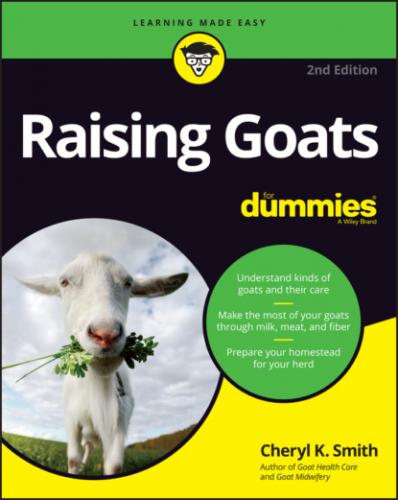Raising Goats For Dummies. Cheryl K. Smith
have to spend time trying to get them to trust you.
Horn-free: Goats without horns are the safest, especially around children. (I tell you more about the horns, including how to remove them before they grow, in Chapter 9.)
Wethers: Don’t ever accept or buy a buck goat for a pet. You will regret it as soon as he matures and starts to stink during breeding season. (Chapter 12 tells you about the weird and exciting world of breeding.) Does can make okay pets, but wethers are the best. They don’t go into heat, and they cost less to feed because they don’t need anything but minerals and good grass hay. They also are the sweetest.
If you live in a city, get miniature goats, not full-sized ones. They won’t take up as much room and then you can have more, if you want. By the same token, if you have a physical disability, miniature goats are better because they are easier to handle. You can read more about miniature goat breeds in Chapter 3.
If you’d like to raise and breed show goats, you probably want to get registered goats. There are many registries for goats, usually related to their use — for example, dairy goats, meat goats, or cashmere goats. I tell you more about showing goats in Chapter 17.
Finding out about local ordinances
Check out ordinances in your area regarding keeping livestock. These govern whether you can keep livestock and restrict the types you can keep. You need to be aware of the ordinances governing your area, or you risk losing the goats that you dreamed of getting just because of a technicality.
In some cities, you may need to buy a license for a goat, just as you do for a dog. Another kind of ordinance that you need to be aware of governs noise. In rural areas, animals are expected (as are guns), so neighbors can’t do much legally about a crying goat (or target shooting). But in an urban area, even if goats are allowed, your neighbors may complain, much as they do with a barking dog. Be aware of what your local noise ordinance covers.
In some cases where goats are prohibited by a city or other municipality, people with special needs or medical issues have been able to obtain variances to the zoning so that a goat could serve as a service or therapy animal.
Also helpful are recommendations on what should be covered by such an ordinance, such as miniature goats only, a limitation on the number, only does or wethers, and whether they need to be licensed. You can use another city ordinance as a pattern for the one you’re proposing.
Knowing your neighbors
Even more important is to know your neighbors. Do they have any vicious or out-of-control dogs that may be a threat to your goats? Can you keep these dogs away from your goats?
Do you already have bad blood with neighbors? Will they bitterly complain, undermine you, or otherwise make your life miserable if they hear goat cries? If you live in an area where you’ll need a livestock guardian dog, will neighbors have a problem with nighttime barking? Try to work things out first, but if you can’t, think about whether you want to invest a lot of time, money, and heart in a project where a nearby neighbor will make your life difficult.
Better yet, if they’re interested, teach your neighbors about goats. You could even offer to work with a neighbor child who is interested in raising goats for 4-H. If you have neighbors who have enough interest, they may be willing to learn enough to be able to care for them so you can take a vacation. It’s a win-win!
Chapter 2
Glimpsing Vital Goat Statistics
IN THIS CHAPTER
Goats are interesting and amazing animals. They’re related to sheep, deer, and cattle but have some basic differences. Talking about goats and their various parts requires you to pick up some new vocabulary.
In this chapter, I give you an introduction to goat terminology, take you through body parts that are integral to “goatness,” and give you some tips on what to expect from a healthy goat and how to tell whether things are starting to go wrong.
Doe, a Goat, a Female Goat
If you want to get goats, you need to talk goats with other goat lovers. To help you avoid missteps, here is the basic terminology that you need to ask questions and talk about goats knowledgeably:
Doe: A female goat. A young doe is called a doeling.You may have heard a female goat called a nanny. But don’t use that term unless you want to offend someone. Some meat goat owners still call their does nannies, but the more common term these days is doe, especially if you’re getting dairy goats.
Buck: A male goat. A young buck is called a buckling.Like nanny goat, billy is also considered a negative term for a male goat, bringing to mind a scruffy, stinking animal. Some meat goat owners still use this term, but in order not to offend, use buck instead.
Brood doe: A doe that is kept and used for breeding purposes, to pass on certain desirable genetic traits.
Kid: A baby goat or a goat less than a year old.
Yearling: A goat that is between one and two years old.
Wether: A castrated male goat.
Herd: A group of goats. Sheep are in flocks; goats are in herds.
Ruminant: An animal that has a stomach with four compartments and chews cud as part of the digestive process. Goats are ruminants.
Udder: The organ in a goat that produces milk. Don’t call it a bag. Goats have only one udder.
Teat: The protuberance from the udder that you use to milk a goat. Goats have two teats.
Dam:
